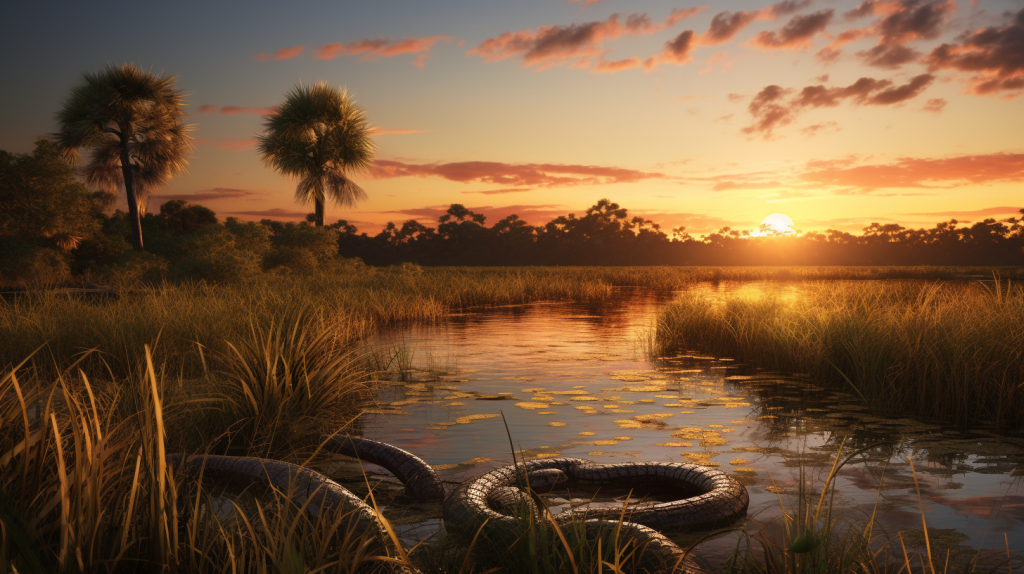In the maze of southern America’s unique ecosystems, there’s a new player slithering around, its the Burmese pythons in Florida. It’s not native, and it’s causing quite the stir. We’re talking about the how these pythons have made their mark in a place that didn’t experience them a few decades ago. Intrigued? Let’s unravel this scaly tale.
The Uninvited Guests: How Did They Get Here?
Nestled amidst Florida’s enchanting landscapes and alluring climate lies an ecosystem that beckons not only tourists but also an array of uninvited guests. Among these, the Burmese python stands out as a peculiar inhabitant, its presence sparking curiosity and raising questions about its origins in the Sunshine State.
The narrative that unfolds is one of unexpected twists, tracing the trajectory from a celebrated exotic pet to an insidious invasive species. Originally imported to cater to the thriving exotic pet trade, these pythons garnered adulation for their mesmerizing patterns and seemingly gentle demeanor. Yet, as they matured into imposing creatures, often stretching beyond 10 feet in length, the novelty wore thin, and the responsibilities grew daunting for many owners.
Faced with the challenges of housing and caring for these formidable reptiles, some individuals resorted to releasing them into the wild, while others unintentionally set them free during natural disasters like hurricanes. This unintended liberation was a turning point that furnished the Burmese pythons with a novel sanctuary: the labyrinthine expanse of the Florida Everglades.
Within this intricate ecosystem, the pythons found the sustenance and conditions to thrive, catalyzing an ecological transformation with far-reaching consequences. The tale of these uninvited guests serves as a cautionary reminder of the intricate interplay between human fascination, ecological balance, and unintended ramifications, urging us to recognize the intricate repercussions of our actions on the delicate tapestry of nature.
Why Are They A Problem?
You might wonder, “It’s just a snake, right? How bad could it be?” Here’s the lowdown: In their native Southeast Asia, Burmese pythons had natural predators that kept their populations in check. However, in the unfamiliar territory of Florida, they’ve become unchecked rulers of the ecosystem, breeding prolifically with minimal natural adversaries to curb their numbers.
The consequences of their presence have led to a disruption of the delicate balance within the ecosystem. These snakes possess an insatiable appetite, devouring a wide array of Florida’s native species, including birds, small mammals, and even other reptiles, leading to a significant decline in their populations.
The feeding frenzy of the Burmese python doesn’t just stop at gobbling up a meal here and there. The ripple effect of their predatory behavior is causing certain species to decline at an alarming rate. This not only disrupts the food chain but also affects the natural balance of predator-prey dynamics.
Astonishingly, reports have even documented Burmese pythons consuming alligators, underscoring their voracious predatory behavior and its impact on the local food web. Furthermore, their sheer size is staggering – imagine coming face to face with a snake longer than your own vehicle. This undeniable presence is nothing short of intimidating, solidifying the Burmese python’s role as an invasive species with profound ecological implications.
State Intervention and Python Hunts
Recognizing the profound threat posed by the invasive Burmese python population, Florida’s environmental agencies have taken decisive action. Enter the python hunts – a novel approach to tackling the issue head-on. Transforming the hunt into a community-driven event, these agencies have harnessed the collective effort of enthusiasts and concerned citizens alike.
The purpose goes beyond mere population control; it’s about raising awareness and actively engaging the public in the fight against this ecological menace. By offering enticing cash prizes and the coveted title of “top python hunter,” these hunts have evolved into eagerly anticipated seasonal events.
This innovative strategy not only serves as a practical method of curbing the python population, but it also fosters a sense of unity and shared responsibility among Floridians, highlighting the pivotal role that community engagement can play in addressing complex environmental challenges.
How You Can Help
Combatting ecological challenges demands a unified effort from individuals and communities alike. Here’s how you can contribute to the cause:
Firstly, exercise caution when considering an exotic pet purchase. Engage in thorough research and consider the long-term commitment required to care for the animal throughout its entire lifespan. By making informed decisions, you can help prevent the unintentional release of species into non-native environments.
Secondly, consider participating in or advocating for initiatives like python hunts. While you might not be directly involved in capturing these snakes, spreading awareness about these events can help garner support and encourage others to take action.
Lastly, staying informed and sharing knowledge is key. By educating yourself about the impact of invasive species and the importance of preserving native ecosystems, you can play a role in promoting community-based solutions. Sharing this information with others can spark conversations and drive more concerted efforts to address the issue at hand. Remember, your individual actions, no matter how small, can contribute to a larger collective effort in safeguarding the delicate balance of our natural world.
Final Thoughts: Controlling The Burmese Pythons In Florida
While Burmese pythons in Florida are awe-inspiring in their might and beauty, their unchecked proliferation in this state poses severe ecological challenges. However, with concerted efforts from both state agencies and the public, there’s hope for the Sunshine State’s delicate ecosystems.
FAQs About Burmese Pythons In Florida
Q: Are Burmese pythons venomous?
A: No, they are constrictors, meaning they suffocate their prey.
Q: How fast is the python population growing?
A: It’s challenging to pin down exact numbers, but estimates suggest tens of thousands are present in Florida.
Q: Why can’t they be removed all at once?
A: Their camouflage and vast breeding numbers make total eradication a monumental task.
Q: Is there any research on controlling their breeding?
A: Yes, various biological control methods are under study, including tracking and sterilization.
Q: How do pythons affect Florida’s tourism?
A: While they pose no direct threat to humans, their impact on native wildlife can deter eco-tourists.
References:
U.S. Fish & Wildlife Service
National Park Service
Florida Fish and Wildlife Conservation Commission





